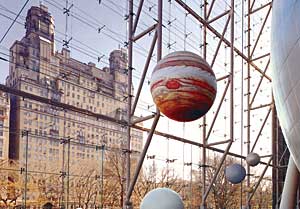21st Century Building Envelope Systems: Merging Innovation with Technology, Sustainability, and Function
Design and Performance Benefits
The point supported, bolted glass system is suitable for new construction and renovation, in any climate zone. Flexibility of design options enables architects to use tinted glass, silkscreen patterns, various colors, as well as large spans of glass. Other advantages include:
- Ability to glaze in any plane, up, over and under, from canopies and roofs to skylights and soffits, without metal framing.
- Enhanced thermal and optical performance, with the use of soft coat Low-E products, to provide better thermal insulation and solar control.
- Acoustical high performance.
- Impact resistance, and tested for various conditions and codes.
- Blast resistance, through the use of specially engineered connections and high-strength laminates.
- Resistance to high winds and seismic loads.
- Design for peak performance properties, including for a super typhoon, equivalent to a Category 5 hurricane in the Far East, for over 200 psf pressure.
This glass system has been tested for hurricane impact in Broward County, Florida. Based on updates to the Florida Building Code, as of Summer 2006, additional test results are pending.
 |
| Point supported bolted glass allows visitors to enjoy natural daylight at the
Rose Center for Earth & Space, American Museum of Natural History, New York City. Architect: Polshek Partnership LLP Photo credit: W&W Glass |
Recent Developments
Bolted glass products have three new and innovative developments, impacting performance and aesthetic qualities.
New technology has allowed the countersunk bolts to be hidden, concealed, or sunk in the glass panel, further eliminating the use of metal. The result enhances the overall look of the glass façade.
Bolted structural glass is fully tempered for strength. New tempering technology is available to create glass that is flatter, and minimize waviness, known as roller wave distortion. During the tempering process, glass softens as it gets hot. Newer tempering furnaces and technology can limit roller wave distortion, thereby improving the optical qualities of tempered glass.
Newer quality control measures and techniques will reduce nickel sulfide, and thereby limit breakage. Nickel sulfide is a contaminant inherent in heavy float glass, which is typically 12mm (about a half-inch) thick, or greater. During the tempering process, contaminants are trapped and can expand, causing spontaneous breakage. The goal during quality control is to limit and catch the nickel sulfide in the glass, and create a safer product through what is known as the heat soaking process.
"These products need complete, fully engineered systems in order for the owner to obtain their full benefit. The glass and related hardware fittings go together, and should ideally be from the same source, not different systems with different warranties, which increases risk to the owner and design professionals," says Jeffrey Haber, Managing Member, W&W Glass, LLC, Nanuet, New York.
To avoid these potential problems, specifications should indicate a single source approach for furnishing and designing the system, to ensure that one manufacturer is responsible for engineering and glass production. This will provide better integration of all system components and warranties, and minimize risk and liability.
As in other building envelope systems, it is important that compatible elements perform to specified loads, meet aesthetic criteria, and don't leak or become maintenance problems over the building and product life cycle, which generally ranges from 20 to 50 years.









